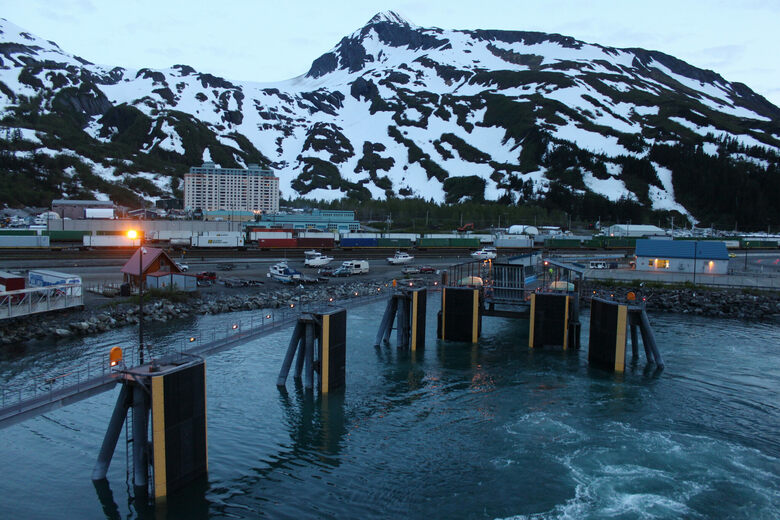Whittier
Gateway of Prince William Sound
Whittier has a popular local slogan “Nowhere prettier than Whittier” and once you get here you’ll see why! Prince William Sound is breathtaking from land and purely majestic from the water. Sea life is abundant here with whales, otters and many sea birds. Some of our 7 day tours take the Alaska Marine Highway Ferry from Whittier to Valdez to soak in all the views that water tour has to offer. We won’t be here long so you’ll want to come back!
Interesting History
Whittier is a city at the head of the Passage Canal in the U.S. state of Alaska, about 58 miles southeast of Anchorage. The city is within the Chugach Census Area, one of the two entities established in 2019 when the former Valdez–Cordova Census Area was dissolved. At the 2010 census the population was 220, up from 182 in 2000. The 2018 estimate was 205 people, almost all of whom live in a single building, the Begich Towers. Whittier is also a port for the Alaska Marine Highway.
During World War II, the United States Army constructed a military facility, complete with port and railroad, near Whittier Glacier and named the facility Camp Sullivan. The spur of the Alaska Railroad to Camp Sullivan was completed in 1943, and the port became the entrance for United States soldiers into Alaska.
The two buildings that dominate the town were built after World War II. The 14-story Hodge Building (renamed Begich Towers) was completed in 1957 and contains 150 two-and-three-bedroom apartments plus bachelor efficiency units. Dependent families and Civil Service employees were moved into this high-rise. The Whittier School was connected by a tunnel at the base of the west tower so students could safely access school on days with bad weather. The building was named in honor of Colonel Walter William Hodge, who was a civil engineer and the commanding officer of 93rd Engineer Regiment on the Alcan Highway.


The other main structure in town, the Buckner Building, was completed in 1953, and was called the “city under one roof”. The Buckner Building was eventually abandoned. Buckner and Begich Towers were at one time the largest buildings in Alaska. The Begich Towers building became a condominium, and along with the two-story private residence known as Whittier Manor, houses a majority of the town’s residents.
The port at Whittier was an active Army facility until 1960. In 1962, the U.S. Army Corps of Engineers constructed a petroleum products terminal, a pumping station and a 62-mile-long, 8-inch pipeline to Anchorage in Whittier.
On March 28, 1964, Whittier suffered over $10 million worth of damage in what became known as the Good Friday earthquake. As of 2019, the earthquake remains the largest U.S. earthquake, measuring 9.2 on the moment magnitude scale, and having caused tsunamis along the West Coast of the U.S. The tsunami that hit Whittier reached a height 43 ft and killed 13 people.
Whittier was incorporated in 1969 and eventually became a port of call for cruise ships. It is utilized by local operations and about 100-passenger mid-sized cruise ships. When the Anton Anderson Memorial Tunnel opened to public access in 2000, it became the first highway to connect Whittier to Anchorage and inner Alaska—previously, the only ways to reach the town had been rail, boat and plane.
After the tunnel expanded access to Whittier, it began to be visited by larger cruise lines. It is the embarkation/debarkation point of one-way cruises from Anchorage to Vancouver by Princess Tours. Whittier is also popular with tourists, photographers, outdoor enthusiasts, paddlers, hikers, sport fishermen, and hunters because of its abundance of wildlife and natural beauty. Whittier is located within the Chugach National Forest, the second-largest national forest in the U.S.
Whittier is in the Chugach School District and has one school serving approximately 48 students from preschool through high school, according to the 2019–2020 enrollment numbers.
The only land access is through the Anton Anderson Memorial Tunnel, a mixed-use road and rail tunnel. The town is on the northeast shore of the Kenai Peninsula, at the head of Passage Canal, on the west side of Prince William Sound. It is 58 miles southeast of Anchorage.
According to the United States Census Bureau, the city has a total area of 19.7 square miles, of which 12.5 square miles of it is land and 7.2 square miles of it (36.36%) is water. As of 2018, there were 205 people living in the city, with 313 available housing units.
